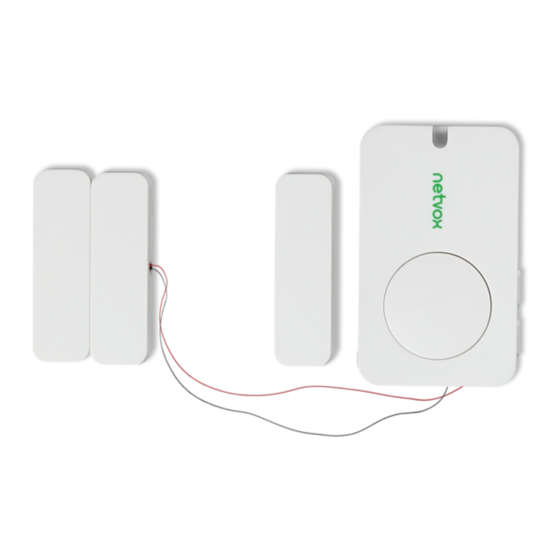Summary of Contents for netvox Z311C
-
Page 1: User Manual
ZigBee - Wireless Window/Door Sensor User Manual Wireless Window Door Sensor Model: Z311C 20131227 FW V2.0 HW V0.1-V1.1... -
Page 2: Table Of Contents
2. Product Appearance.............................4 3. Specification................................5 4. Installation Diagram..............................5 5. Setting up Z311C..............................6 5.1. Turn On/ Turn Off Z311C..........................6 5.2. Join the ZigBee Network..........................6 5.3. Enroll in the ZigBee Security System......................7 5.4. Sleeping Mode..............................7 5.5. Wake up Z311C...............................7 5-6. -
Page 3: Introduction
Netvox Z311C, a Window/Door Sensor and Glass Sensor, acts as an End Device in ZigBee network. It does not perform permit-join function as a coordinator or a router for other devices to join the network. Z311C is featured to play a role of the sensor (Zone device) in the ZigBee security system. It is installed for being the window/door opening detector. -
Page 4: Product Appearance
2. Product Appearance Indicator (Red/ Green) Magnetic Contact Extended Magnet Extended Contact Battery Cover Extended Contact Input Binding Key Auxiliary Key... -
Page 5: Specification
3. Specification Fully IEEE 802.15.4 compliant Utilizes 2.4GHz ISM band; up to 16 channels Power supply: 2 x 3V CR2450 button cell batteries. Operating consumption: ≤ Tx ≤ 43mA; Rx ≤ 28mA Standby consumption: ≤ 3.5uA ... -
Page 6: Setting Up Z311C
5 times after it is joined successfully. Otherwise, the indicator will not flash. Z311C will stop searching and go to turn-off mode when it doesn’t find a network to join in 15 seconds. Press the Binding Key again to turn it on for searching and joining the network. -
Page 7: Enroll In The Zigbee Security System
C. Once Z311C was joined to a network and by any chance the network is no longer existed or the device is out of the network → Z311C will wake up every 15 minutes to find the network it joined before. - Page 8 Under the circumstances that Z311C has enrolled to the security system, it will send the contact status to the command center (and the bound devices with ID: 0x0500) after triggering. The Warning Device will send out alarm sound or lighting alert for warning.
-
Page 9: Heartbeat Technique
CIE device). To meet this need, Netvox came up with a technique called “HeartBeat”. Right after Z311C enrolls to a security system, it sends a HeartBeat signal to the CIE device. Afterward, it will send HeartBeat data every hour by default settings. -
Page 10: Home Automation Clusters For Z311C
A cluster is a set of related attributes and commands which are grouped together to provide a specific function. A simple example of a cluster would be the On/Off cluster which defines how an on/off switch behaves. This table lists the clusters which are supported by Z311C. 1.End Point(s):0x01: 2.Device ID:IAS Zone(0x0402)... - Page 11 0x0010 LocationDescription Character 0 – 16 Read/write string bytes 0x0012 DeviceEnabled Boolean 0x00 – Read/write 0x01 0x01...
-
Page 12: Important Maintenance Instructions
7. Important Maintenance Instructions Please keep the device in a dry place. Precipitation, humidity, and all types of liquids or moisture can contain minerals that corrode electronic circuits. In cases of accidental liquid spills to a device, please leave the device dry properly before storing or using. ... - Page 13 FCC Statement: This device complies with part 15 of the FCC Rules. Operation is subject to the following two conditions: (1) This device may not cause harmful interference, and (2) this device must accept any interference received, including interference that may cause undesired operation. This equipment has been tested and found to comply with the limits for a Class B digital device, pursuant to part 15 of the FCC Rules.















Need help?
Do you have a question about the Z311C and is the answer not in the manual?
Questions and answers